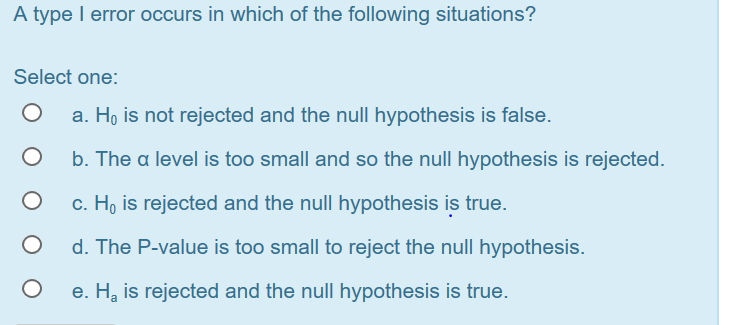Chegg Which of the Following Is a Type-i Error
In other words it falsely infers the existence of a phenomenon that does not exist. Which of the following best describes a type I error.
Solved Identify The Type I Error And The Type Ii Error That Chegg Com
Start studying Type I and Type II Errors.

. The null is false but we fail to reject it. The null is false and we reject it. Rejecting the null hypothesis when the null hypothesis is true.
Use a one-tailed test only if you have a convincing reason for predicting the direction. For the given data Hypothesis. Start studying Probability - Type I Errors and Type II Errors.
The null is false but we fail to reject it. Learn vocabulary terms and more with flashcards games and other study tools. Which is type II error.
This means that your report that your findings are. A type 1 error is also known as a false positive and occurs when a researcher incorrectly rejects a true null hypothesis. Which of the following is a type I error.
Choosing a value α is sometimes called setting a bound on Type I error. A type I error is. A Type I error means rejecting the null hypothesis when its actually true.
The null is false and we reject it. Experts are tested by Chegg as specialists in their subject area. A type I error occurs if you reject the null hypothesis when it is true.
Now the hypotheses are. It means concluding that results are statistically significant when in reality they came. Correlation analysis can ONLY be performed on linear relationships.
Answer choices The null is true but we mistakenly reject it. α is also called the bound on Type I error. A type I error appears when the null hypothesis H 0 of an experiment is true but still it is rejected.
The soil is actually. Which of the following best describes a type I error. Fail to reject accept the null hypothesis when the null hypothesis is false.
Learn vocabulary terms and more with flashcards games and other study tools. The broker rejects the hypothesis that the mean price is 243755 when the true mean price is less than 243755. B Which of the following is a Type I error.
Type 1 and type II errors are mistakes in testing a hypothesis. Answer 1 of the following. A type I error occurs when the results of research show that a difference exists but in truth.
The broker fails to reject the hypothesis that the mean price is 243755 when the true mean price is less than 243755. Another good reason for reporting p-values is that. The proportion of settled medical malpractice suits is 021.
Which of the following would be a Type I error in this setting. μ400 ppm soil is safe and H1. Use a two-tailed test only if you have a convincing reason for not.
μ400 ppm soil is unsafe. It is stating something which is not present or a false hit. The type I error is also known as the false positive error.
Continuous data dependence OR random sampling Question 3. Which of the following is a type I error. Answer choices The null is true but we mistakenly reject it.
Fail to reject the claim that the proportion of people who write with their left hand is 024 when the proportion is actually 024. We review their content and use your feedback to keep the quality high. 12 Type I and Type II Errors.
Learn vocabulary terms and more with flashcards games and other study tools. Describe the type I error and the type II error for a hypothesis tests of the given claim. Type I error.
The proportion is 0398 The proportion is less than 0398 If in actual fact the. Note that the type I error does not imply that. Here are the hypotheses for this test.
Always use two-tailed tests.

Solved A Which Of The Following Statements About Type I And Chegg Com

Solved A Type I Error Occurs In Which Of The Following Chegg Com

Solved Which Of The Following Regarding The Type I And Type Chegg Com

Solved 1 Which Of The Following Statements About Type I And Chegg Com
No comments for "Chegg Which of the Following Is a Type-i Error"
Post a Comment